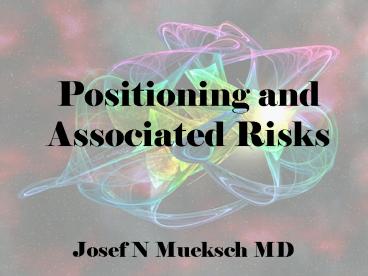Positioning and Associated Risks - PowerPoint PPT Presentation
1 / 33
Title:
Positioning and Associated Risks
Description:
If placed at chest level may compress artery. Consider SPO2 on dependent Arm. Lithotomy ... Facilitates drainage of head. CPP. CV Effects. CO. VAE largest risk ... – PowerPoint PPT presentation
Number of Views:103
Avg rating:3.0/5.0
Title: Positioning and Associated Risks
1
Positioning and Associated Risks
- Josef N Mueksch MD
2
(No Transcript)
3
Zero Commercial Interests
4
Problems
- Often after anesthesia initiated
- Physiologic Compromise
- Blood Vessels
- Nervous Tissues
- Physical Compromise
- NDMR facilitate abnormal position
- Mac/GA facilitate uncomfortable positions
5
Responsibility
- Team Effort
- Anesthesiologist Ultimately
Responsible
6
Why We Really Care!
7
Agenda
- Positions
- Specific Nerves
- Special Cases
8
Supine
- Pulmonary Effects
- FRC 800cc
- even more with NDMR
- MS Effects
- Pad Pressure Points (heels, occiput)
- Loss Lumbar Curvature
- Often Results in Post-Op Backache
9
Supine
- Arm Position
- Abducted
- Supination preferred
- May place increased stress on brachial plexus
- Adducted (Tucked at side)
- Tuck under patient, NOT BED!
10
Prone
- Pulmonary Effects
- Compression Abdominal Contents
- FRC even further
- PIP increases
- Consider rolls Chest Iliac Crest
- MS Effects
- Turning of head
- Arterial Venous flow
- Risk of Thromboembolism
- Pad Pressure Points (Face)
11
Prone
- Arm Position
- Above Head
- Risks
- Thoracic Outlet Syndrome
- Brachial Plexus Injury
- Tucked at side
12
Trendelenburg
- Neuro Effects
- Increases ICP
- CV Effects
- Does not reliable increase preload
- May worsen hypotension
- Pulmonary Effects
- FRC even further more
13
Lateral Decubitus
- CV Effects
- IVC Compression
- Pulmonary Effects
- V/Q Mismatch
- Dependent Lung Hypoventilated
- Dependent Lung Hyper-perfused
- MS Effects
- Neck Position
- Avoid Traction on Brachial Plexus
- Pad Pressure Points (Between Knees)
- Arm Position
- Dependent Compress Neurovascular Bundle
- Placement of Axillary Roll
- If placed at chest level may compress artery
- Consider SPO2 on dependent Arm
14
Lithotomy
- Position Itself
- 800-1000 thigh flexion with trunk
- Legs abducted 300-450
- Lift both legs together
- Avoids rotational stress on spine
- CV Effects
- Compress or occlude venous return
- Pulm Effects
- Abdominal contents pushed cephalad
- Neuro Effects
- Worsens Herniated Disc Pain
- Many Peripheral Nerve Injuries
15
Sitting
- Neuro Effects
- Facilitates drainage of head
- CPP
- CV Effects
- CO
- VAE largest risk
- May completely occlude blood flow to the
head
16
Summary
17
(No Transcript)
18
Peripheral Nerves
- Significant source of liability
- Mechanism often unknown
- Ischemia?
- Compression?
- Stretch?
19
Peripheral Nerves
- What to do?
- Neurology Consult
- EMG Studies
- Denervation takes 18-21 days
- If present post-op, maybe already existed
- Recovery?
- Takes 3-12 months
- If at all!
20
Peripheral Nerves
- Ulnar Nerve
- Occurs at elbow more often in males
- Thought secondary to pronation
- Severe Flexion also causes
- Cubital Tunnel Entrapment Syndrome
- Thicker FCU retinaculum
- Overzealous BP Cuff/Tourniquet
- Manifestations
- Diminished Sensation 4th and 5th digits
- Claw Hand
21
Peripheral Nerves
- Radial Nerve
- Compression against humerus
- Overzealous BP Cuff/Tourniquet
- Metal Drape Bar (heart room)
- Manifestations
- Decreased sensation over lateral 3 fingers
- Wrist Drop
- Weak Thumb ab/adduction
22
Peripheral Nerves
- Median Nerve
- Unlikely
23
Peripheral Nerves
- Sciatic Nerve
- Stretch Injury
- Knee extension and external rotation
- Often in lithotomy position
- Direct Injury
- Needle
- Inject upper outer quadrant
- Manifestations
- Foot Drop
24
Peripheral Nerves
- Common Peroneal Nerve
- Compression against Fibula
- Candy Canes
- Tourniquet
- Manifestations
- Foot Drop
- Mimics sciatic nerve
- (It is part of sciatic nerve!)
25
Peripheral Nerves
- Saphenous Nerve
- Compression against Fibula
- Candy Canes
- Tourniquet
- Manifestations
- Decreased Sensation medial leg
26
Peripheral Nerves
- Femoral Nerve
- Compression against pelvic brim
- Laparotomy retractor
- Excessive thigh flexion
- Lithotomy position
- Manifestations
- Loss knee jerk
- Decreased sensation
- Superior thigh
- Anteriormedial leg
27
Peripheral Nerves
- Obturator Nerve
- Forceps delivery
- Excessive thigh flexion
- Manifestations
- Inability to Adduct
- Decreased sensation medial thigh
28
Non-Neural
- Skin
- Pressure necrosis
- Eyes
- Compression Thrombosis BLIND!
- Increased with hypotension
- Corneal Abrasion
- Appendages
- Caught in bed
- Compressed
29
Sternal Retraction
- Neuro Effects
- Brachial Plexus Stretch Injury
- Often Ulnar distribution
30
Blood Supply
- Loss of blood supply leads to
- Ischemia
- Hypoxic Edema
- Rhabdomyolysis
- leading to
- Compartment Syndrome
31
Anesthesia Mask
- Facial Nerve
- Prolonged force behind mandible
- Supraorbital Nerve
- Circuit resting on patient
- Pressure Necrosis
- Prolonged mask placement with strap
- Often in mask cases
32
References
- Baby Miller
- Chapter 15 pgs 196-208
- Fausts Anesthesiology Review
- Chapter 198 pgs 480-1
- Morgan and Mikhail
- Chapter 46
- Millers Anesthesia
- Chapter 28
33
Any Questions
Get Outta Here































